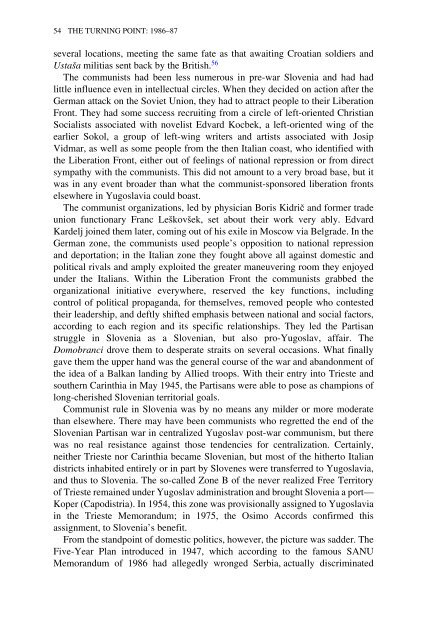Yugoslavia: A History of its Demise - Indymedia
Yugoslavia: A History of its Demise - Indymedia
Yugoslavia: A History of its Demise - Indymedia
Create successful ePaper yourself
Turn your PDF publications into a flip-book with our unique Google optimized e-Paper software.
54 THE TURNING POINT: 1986–87<br />
several locations, meeting the same fate as that awaiting Croatian soldiers and<br />
Ustaša militias sent back by the British. 56<br />
The communists had been less numerous in pre-war Slovenia and had had<br />
little influence even in intellectual circles. When they decided on action after the<br />
German attack on the Soviet Union, they had to attract people to their Liberation<br />
Front. They had some success recruiting from a circle <strong>of</strong> left-oriented Christian<br />
Socialists associated with novelist Edvard Kocbek, a left-oriented wing <strong>of</strong> the<br />
earlier Sokol, a group <strong>of</strong> left-wing writers and artists associated with Josip<br />
Vidmar, as well as some people from the then Italian coast, who identified with<br />
the Liberation Front, either out <strong>of</strong> feelings <strong>of</strong> national repression or from direct<br />
sympathy with the communists. This did not amount to a very broad base, but it<br />
was in any event broader than what the communist-sponsored liberation fronts<br />
elsewhere in <strong>Yugoslavia</strong> could boast.<br />
The communist organizations, led by physician Boris Kidrič and former trade<br />
union functionary Franc Leškovšek, set about their work very ably. Edvard<br />
Kardelj joined them later, coming out <strong>of</strong> his exile in Moscow via Belgrade. In the<br />
German zone, the communists used people’s opposition to national repression<br />
and deportation; in the Italian zone they fought above all against domestic and<br />
political rivals and amply exploited the greater maneuvering room they enjoyed<br />
under the Italians. Within the Liberation Front the communists grabbed the<br />
organizational initiative everywhere, reserved the key functions, including<br />
control <strong>of</strong> political propaganda, for themselves, removed people who contested<br />
their leadership, and deftly shifted emphasis between national and social factors,<br />
according to each region and <strong>its</strong> specific relationships. They led the Partisan<br />
struggle in Slovenia as a Slovenian, but also pro-Yugoslav, affair. The<br />
Domobranci drove them to desperate stra<strong>its</strong> on several occasions. What finally<br />
gave them the upper hand was the general course <strong>of</strong> the war and abandonment <strong>of</strong><br />
the idea <strong>of</strong> a Balkan landing by Allied troops. With their entry into Trieste and<br />
southern Carinthia in May 1945, the Partisans were able to pose as champions <strong>of</strong><br />
long-cherished Slovenian territorial goals.<br />
Communist rule in Slovenia was by no means any milder or more moderate<br />
than elsewhere. There may have been communists who regretted the end <strong>of</strong> the<br />
Slovenian Partisan war in centralized Yugoslav post-war communism, but there<br />
was no real resistance against those tendencies for centralization. Certainly,<br />
neither Trieste nor Carinthia became Slovenian, but most <strong>of</strong> the hitherto Italian<br />
districts inhabited entirely or in part by Slovenes were transferred to <strong>Yugoslavia</strong>,<br />
and thus to Slovenia. The so-called Zone B <strong>of</strong> the never realized Free Territory<br />
<strong>of</strong> Trieste remained under Yugoslav administration and brought Slovenia a port—<br />
Koper (Capodistria). In 1954, this zone was provisionally assigned to <strong>Yugoslavia</strong><br />
in the Trieste Memorandum; in 1975, the Osimo Accords confirmed this<br />
assignment, to Slovenia’s benefit.<br />
From the standpoint <strong>of</strong> domestic politics, however, the picture was sadder. The<br />
Five-Year Plan introduced in 1947, which according to the famous SANU<br />
Memorandum <strong>of</strong> 1986 had allegedly wronged Serbia, actually discriminated
















